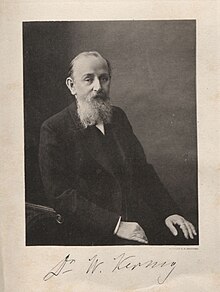This article includes a list of general references, but it lacks sufficient corresponding inline citations. (January 2023) |
Woldemar Kernig, better known as Vladimir Mikhailovich Kernig (Latvian: Voldemārs Kernigs; Russian: Владимир Михайлович Керниг; 28 June 1840 – 18 April 1917) was a notable Russian and Baltic German internist and neurologist whose medical discoveries saved thousands of people with meningitis. He is best known for his pioneering work on diagnostics. Kernig's sign is named after him.
Woldemar Kernig | |
|---|---|
 | |
| Born | 28 June 1840 |
| Died | 18 April 1917 (aged 76) St. Petersburg, Russia |
| Citizenship | |
| Alma mater | University of Tartu |
| Known for | The Kernig's sign, which may indicate subarachnoid haemorrhage or meningitis |
| Scientific career | |
| Fields | internal medicine, neurology |
| Institutions | Obuchow Hospital in St. Petersburg |
Biography
editWoldemar Kernig was born in St. Petersburg in 1840 to a bookbinder of German origin, Benjamin Mikhail Kernig (1788-1862) and his spouse Wilhelmina Elizaveta (née Person). He received his early education at St. Peter's School from 1852 to 1856. In 1864, he graduated from Universität Dorpat with the degree of Doctor of Medicine for his dissertation about variations in body temperature in sick and healthy people (German: Experimentelle Beiträge zer Kenntniss der Wärmeregulirung beim Menschen). In the same year he began to work at Obukhovskaya Hospital in St. Petersburg, becoming a physician-resident in 1865.
From 1873 to 1890, he was a doctor at a school for deaf-mutes, and from 1881 to 1886 he taught internal medicine in medical courses for women. From 1884 he was a consultant in internal medicine for the Office of the Institutions of Empress Maria (Russian: Ведомство учреждений императрицы Марии, romanized: Vedomstvo uchrezhdeniy imperatritsy Marii). He was chairperson of the Society of German Physicians in St. Petersburg.
From 1890 to 1911 he was chief physician at Obukhovskaya Hospital. In 1911 he entered retirement with the title "Respected Consultant of the Hospital."
He died in Petrograd on April 19, 1917. He was buried in the Smolensky Lutheran Cemetery.
Kernig's sign
editIn Kernig's original 1882 publication, he wrote that in patients with meningitis who are seated upright with hips and knees flexed, extending the knee beyond 135 degrees would be painful. Today patients are put into a supine position instead of being seated upright.[1]
Other achievements
editIn 1904, Kernig described acute pericarditis after severe attacks of angina pectoris and gave an explanation of its pathogenesis, forming part of the foundational research on myocardial infarction. He was one of the principal organizers of higher women's medical education in Russia and provided initiative for the establishment of the Medical Institute for Women (Russian: Женский медицинский институт, romanized: Zhenskiy meditsinskiy institut).
See also
editReferences
edit- ^ Saberi, Asif; Syed, Saeed A. (July 1999). "Meningeal Signs: Kernig's Sign and Brudzinski's Sign" (PDF). Hospital Physician. Wayne, PA: Turner White Communications: 23–24. Retrieved 2012-12-05.
- Russian State Historical Archive, Collection #272, List #1, Section #48
- Erik Amburger Database: Foreigners in Pre-Revolutionary Russia
Publications
edit- Über Milzabscesse nach Febris recurrens. St. Petersburger medicinische Zeitschrift, 1867, XII.
- Über subfebrile Zustände von erheblicher Dauer. Deutsches Archiv für klinische Medicin, Leipzig, 1879, XXIV.
- Über ein krankheitssymptom der acuten meningitis. St. Petersburger Medizinische Woschenschrift, 1882;7:398
- Vorläufiger Bericht über die in der Frauenabteilung des Obuchow-Hospitals nach Koch’scher Methode behandelten Schwindsüchtigen. Deutsches Archiv für klinische Medicin, Leipzig, 1891, XVI.
- Über subcutane Injectionen an den Lungenspitzen ohne pathologische Veränderungen an denselben. Deutsches Archiv für klinische Medicin, Leipzig, 1898; XXXIV.
- Bericht über die mit Tuberculin R im Obuchow-Frauenhospital behandelten Lungenkranken. St. Petersburger medicinische Wochenschrift, 1898; XXIII.
- Russian: О перикадите и других объективных изменениях в сердце после приступов грудной жабы, romanized: O perikardite i drugikh ob'ektivnykh izmeneniyakh v serdtse posle pristupov grudnoy zhaby (Russian: «Русский врач», romanized: Russkiy vrach, 1904, № 44)
Further reading
edit- M. Welz, A. Lindner. Vladimir Kernig (1840–1917). Der Nervenarzt 2003;74:935-936 (German)
- M Krasnianski, P Tacik, T Müller, S Zierz. Attenuation of Kernig’s sign by concomitant hemiparesis: forgotten aspects of a well known clinical test. Journal of Neurology, Neurosurgery, and Psychiatry 2007;78:1413-1414